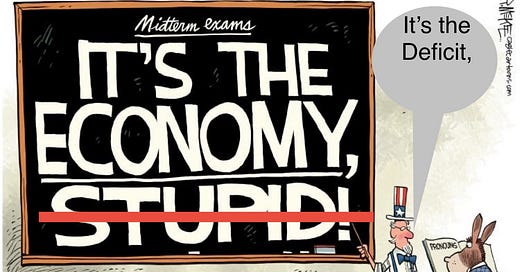This past weekend, Congress passed yet another massive spending bill, adding to an already astronomical government deficit. At an estimated cost of $2.75 trillion for the fiscal year 2025, this bill marks the second-highest government spending level in U.S. history—second only to 2020, when the government unleashed unprecedented spending in response to the pandemic. However, unlike in 2020, Americans are not receiving stimulus checks to offset the pain of inflation, making this latest development even more alarming.
The issue at hand is simple: it's the deficit, st*pid. This phrase is a play on the famous political slogan from Bill Clinton’s 1992 presidential campaign, “It’s the economy, stupid,” which was used to highlight economic issues as the central concern for voters.
Today, the real driver of economic instability is the government’s reckless deficit spending. Washington continues to spend beyond its means, fueling inflation and eroding the purchasing power of everyday Americans. As prices rise, wages struggle to keep up, and savings lose value, the average American bears the burden of irresponsible fiscal policy.
Why Is the Deficit So Large?
The primary reason the deficit remains historically high is simple: government spending continues to rise while tax revenue stagnates. Without increasing its tax receipts, the government must cover the gap by creating new money—essentially printing it out of thin air. This influx of new dollars into the economy without a corresponding increase in goods and services inevitably leads to higher prices.
Even though this latest spending bill adds trillions to the deficit, its percentage of GDP appears smaller compared to 2020. Back then, the deficit was 13.3% of GDP, while in 2025, it's projected to be around 6.2%. However, this is not because the government has reduced its debt burden—it’s because inflation has artificially inflated GDP figures. In other words, higher prices make the economy look bigger on paper, but the fundamental issues remain unresolved.
Inflation: The Unstoppable Consequence of Deficit Spending
Government deficit spending fuels inflation, which erodes the purchasing power of everyday Americans. With no serious efforts to curb spending, prices will continue to rise indefinitely. The Federal Reserve's previous rate hikes temporarily slowed the inflation rate, but as soon as rates stabilized, deficits resumed their expansion, leading to continued economic uncertainty.
The Case for Gold
As the government continues to devalue the currency through reckless spending, the need for a reliable store of value becomes even more critical. This is why gold—long regarded as a hedge against inflation—is seeing renewed investor interest, recently surpassing $3,000 per ounce.
Keep reading with a 7-day free trial
Subscribe to The Coastal Journal to keep reading this post and get 7 days of free access to the full post archives.





